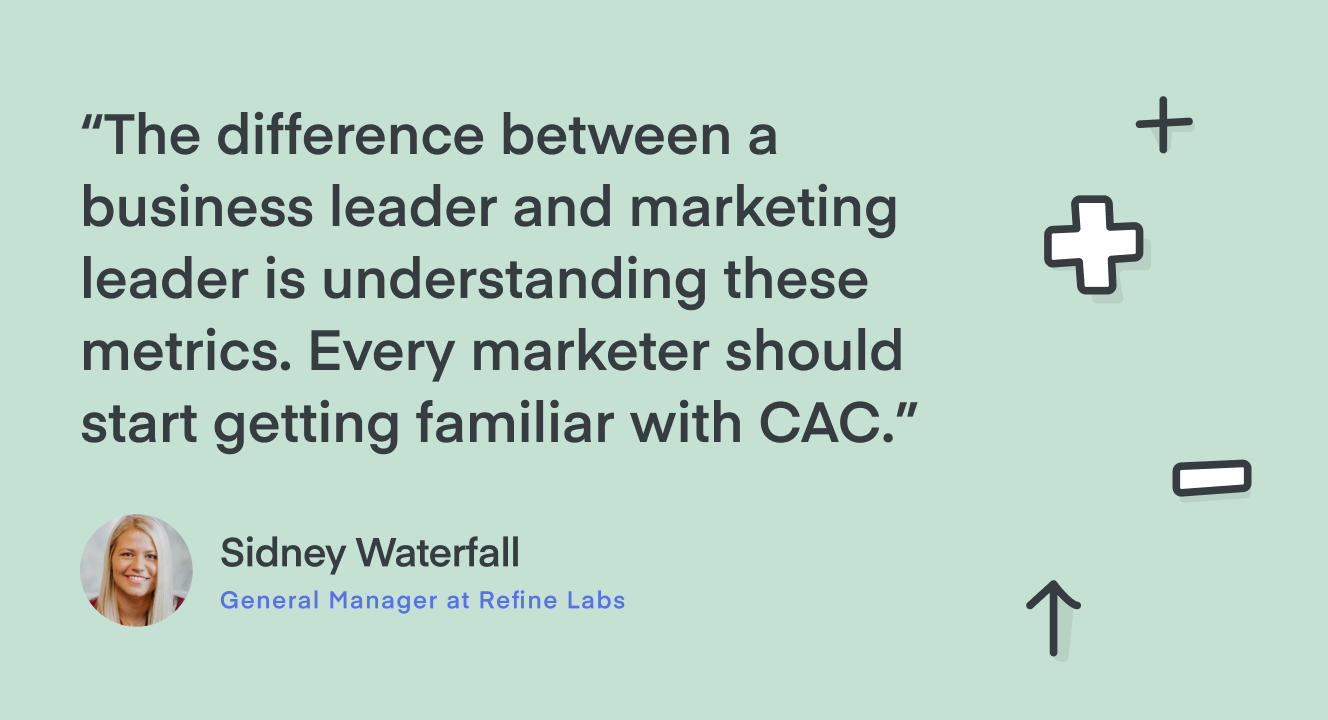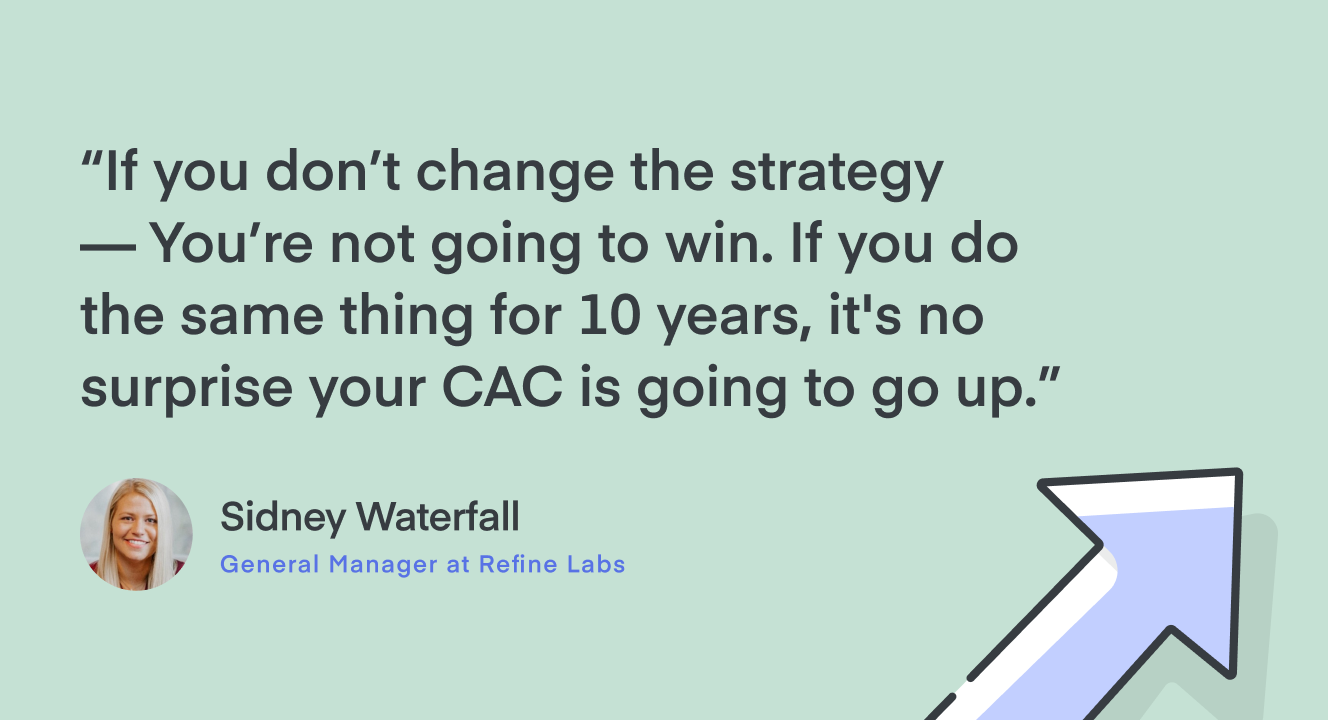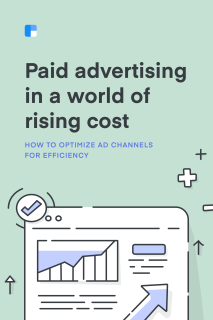Chapter 2
7 minutes
CAC: What it is, why it’s rising, and why marketers should care
A great way to start aligning your paid ad strategies and marketing efforts with your finance team’s need for cost efficiency is to familiarize yourself with customer acquisition cost (CAC).
Marketers don’t typically think about CAC on a regular basis until they reach a company leadership level, but it’s a business metric that leaders understand well.
CAC goes one level higher than cost per acquisition (CPA). It’s a measure of business health, not just the cost of a lead. And, it measures a marketer’s success with more than revenue and pipeline because it takes costs into account.
Marketers who understand CAC earn a seat at the revenue table because they can measure the efficiency of their paid ad spend, gauge their department’s effect on company fitness, and pivot to profit-focused marketing strategies as external conditions change.
With marketing costs ballooning, there’s no better time to cultivate that kind of agility.
What is CAC?
Customer acquisition cost (CAC) is your company’s total cost to acquire a paying customer.
Customer acquisition cost formula
To calculate it, take the full spend of your go-to-market (GTM) organization — typically the marketing and sales teams — and divide by the total number of new customers that were won in the same time period.
When we say GTM spend, we mean all of it, including marketing campaigns, employee salaries, commissions, taxes, benefits, business travel, training, and recruiting spend. Fully loaded.

CAC is different from cost per acquisition (CPA).
CAC only counts paying customers, whereas CPA may count a non-paying lead/potential customer or other conversions as an acquisition. CPA is often calculated for a specific marketing channel or a specific campaign (e.g., “paid media” or “spring launch campaign”), and it accounts for just that part of the budget, rather than the entire marketing and sales organizations’ spend.
CAC subtypes
Some teams find it helpful to look at CAC “subtypes” that measure the efficiency of different efforts within GTM. Examples include Marketing CAC and Advertising CAC:


Looking at all three types – Total CAC, Marketing CAC, and Advertising CAC — can add color to your picture of business health.
But no matter which CAC subtype we’re calculating, notice that we always use the same denominator: all customers won. If we’re calculating advertising CAC, we’re still using the blended “all customers” number — not just customers attributed to paid ads. This is because attribution technology isn’t perfect, and ad spend influences organic traffic.
Once you know your CAC, you can track other metrics, like CAC payback and LTV:CAC ratio.
CAC payback
CAC payback is the time it takes for a paying customer to recoup their acquisition cost for the business.
Sidney Waterfall is VP of Demand Gen at Refine Labs, a digital marketing and go-to-market agency based in Boston. She uses CAC and CAC payback calculations to optimize paid strategies for clients.
“At Refine Labs, we’ve had customers with a very low advertising CAC payback — two months, for example,” Sidney says. “This is a signal that we may want to put our foot on the gas and invest more in marketing and ads to spur growth.”
LTV:CAC ratio
The ratio of customer lifetime value (LTV) to CAC is another indicator of business health. The gold standard is 3:1, meaning a customer’s LTV is three times as much as what you’ve spent to acquire them.
If it’s less — and you’re only getting double your investment, for example — it’s time to reevaluate your spend and strategies.
Why do marketers need to think about CAC?
If you’re thinking, “I didn’t go into marketing to deal with all this math,” we understand you.
And yet, these metrics will help you if you’re a tactical marketer moving up in your organization — or a marketing leader transitioning to a business leader role.

CAC helps you discern whether you’re running an efficient GTM organization by taking costs into account. This is what your executive and finance teams care about. When your CFO and CEO know you’re thinking about CAC too, it builds trust, helping you justify ad budget requests and strategic shifts.
Understanding CAC elevates marketers.
Sidney says, “Your finance team likely wants to share CAC data and discuss how your company is trending. They may not give you calculations with private information like salaries, but I think questions about CAC are acceptable for anyone at any level to ask. Looking at these benchmarks and metrics is how you start shifting your mindset.”
Why is CAC rising in B2B SaaS?
From ad platforms to sponsorships, marketing expenses are much higher these days.
Although the COVID-19 pandemic is partly to blame, CAC was already on the rise, increasing 60-75% for both B2C and B2B businesses from 2014 to 2019, according to a Profitwell study of 700 subscription businesses.
Broader trends in online browsing and buying have hit paid media costs particularly hard.
Supply and demand
Paid media is facing supply and demand issues; there are more advertisers than ever jostling for a finite amount of digital ad inventory.
Recent cash injections into tech and B2B have resulted in a much higher number of companies advertising overall, and they’re also competing with the boom in B2C and ecommerce D2C brands that moved online during the COVID-19 pandemic.
Buying behavior is changing
The buyer’s journey has morphed. Ten years ago, people learned about products through gated content, analyst reports, and tradeshows.
These days, people prefer to remain anonymous while they research. They also want to learn from peers via dark social, including difficult-to-track platforms like Discord, Slack, Reddit, and YouTube, as well as one-on-one conversations like texting, email, and DMing on LinkedIn.
Sidney explains, “These platforms have become popular for sharing information and finding out a product’s pricing and packaging — before a person comes to the website and becomes a known user.”
Marketers need to shift their paid ad strategies to match these new research behaviors, and we’ll share how in the coming chapters.
Online privacy is locking down, making targeting harder
When marketers want to drive down advertising costs, targeting is one of the most effective levers. But targeting is getting more difficult due to rising online privacy regulations.
There’s GDPR, Apple app tracking transparency, and the deprecation of cookies. Consumers are switching to privacy-oriented browsers, and Apple is coming for email next.
Because of this decreased ability to target, we’re seeing marketers resort to broader, less efficient advertising. Some pull spend away from specific paid platforms where they lack confidence in their targeting abilities — which are often the same dark social media platforms their prospects are gravitating to.
Reduced engagement due to more competition, more channels, and more platforms
Engagement on paid platforms is trending down. Think about your own behavior: if you’re on Facebook or Instagram, we’re willing to bet that you scroll and lurk more than you used to, and you post, click, and share less.
Consumers are increasingly reluctant to click on ads, wary of being virtually “followed around” or “listened to.” And there are more platform players than ever today, pulling people’s attention to less-trackable spaces (e.g., users moving from Facebook to Reddit and Discord).

Consumers know that if they click on an ad, it can flood their online life forever. Clearbit’s demand team found this out the hard way with ads for “Iron Neck.” (Whatever you do, don’t click on one.)
“People are more protective and aware of their privacy now, compared to five to seven years ago, when they were filling out lead forms with their mobile number,” Sidney points out. “Today, you can hurt your brand if you don’t balance that.”
All this means that marketers can no longer count on engaged users, low ad costs, and the same targeting methods they’ve used in the past.

With these macro forces at play, marketers are quickly putting their old lead gen playbooks out of business.

